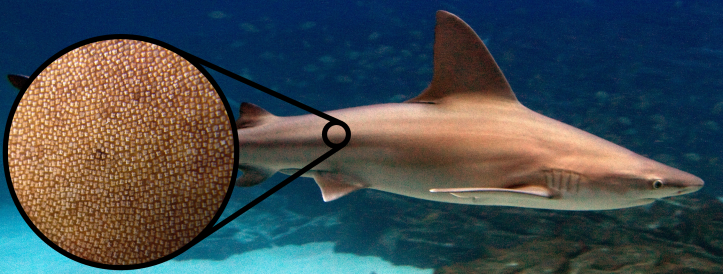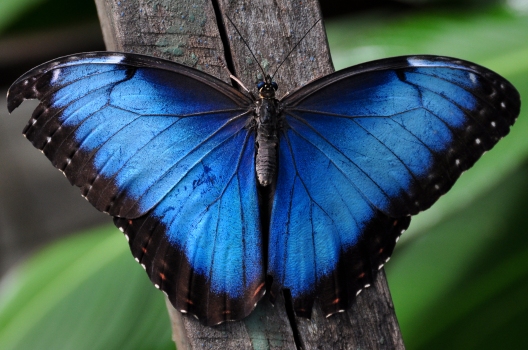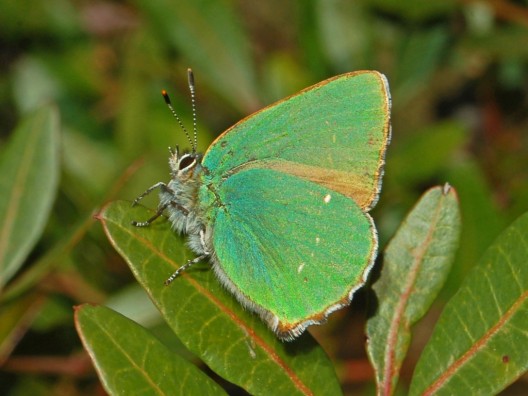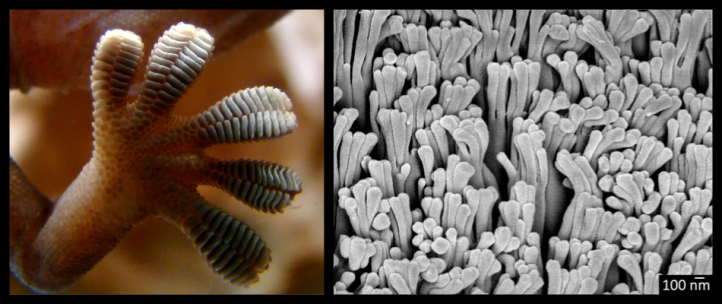Only over the past 20 years have we begun to harness the unique properties of nano-scale materials, while nature has been using nano- “technology” since the beginning of time to prevent infections, repel water, create colors, and climb vertical surfaces. Inspired by nature’s advances, scientists and engineers are generating biomimetic applications for nanotechnology in today’s world.
Shark Skin: The power of anti-bacterial invincibility
Sharks have been swimming in the oceans for millions of years without the problematic accumulation of algae and bacteria on the surface of their skin. This is because the nano-scale patterns on the shark’s skin deflect the accumulation of barnacles, algae, and bacteria (Figure 1). Algae and bacteria tend to settle on surfaces and ultimately establish colonies and biofilms. It is easier to colonize a smooth surface, whereas establishing a biofilm over a rough surface requires too much energy for colonization and makes signaling between cells in the colony difficult. Surfaces that prevent the underwater growth of bacteria, algae, and organisms are known as anti-fouling. These surfaces are essential for maintaining functional pipelines, ships, submarines, and other submerged infrastructures and technologies. Until now, anti-fouling techniques have primarily involved coating surfaces with chemicals that can be toxic to humans and the environment, in addition to their bacterial and algal targets. To avoid these problems, scientists and engineers have begun to integrate this anti-bacterial nano-scale pattern onto high-traffic surfaces. Sharklet Technologies Inc. has incorporated this pattern onto railings and door handles in airports and hospitals and also on medical equipment to reduce bacterial colonization.

Image adapted from: Source1 Source2
The Lotus Effect: The super-hydrophobic power of self cleaning
The leaves of the lotus flower exhibit extremely water-repellent properties due to micro and nano-structures on the leaf surface. These structures allow the plant to have a magnificent self-cleaning function (Video 1). How does the lotus leaf surface enable this? The behavior of water on the leaf surface is key. This behavior is dependent upon the balance of water’s inherent attraction to itself and its attraction to air and solid surfaces.
Water tends to stick most readily to smooth surfaces, as the area of contact between the water and the surface is large. Rough surfaces contain tiny pockets of air, to which water is only weakly attracted. These pockets of air act as barriers, preventing water from interacting with the solid surface below. As a result, the water’s attraction to itself overcomes its attraction to the leaf surface of the lotus flower, and it forms tiny droplets that roll off the leaf instead of spreading out and making the leaf wet.
So how does this lead to self-cleaning? The water droplets are prevented from interacting with the solid leaf surface, but that doesn’t stop them from interacting with other nearby solids, like dirt. Water droplets pick up dirt on the lotus leaf because the attraction of the dirt to the water droplet is greater than the attraction of the dirt to the leaf. Therefore the water droplet picks up the dirt as it rolls off the leaf.
This concept has been extrapolated and applied to sealing windshields, waterproofing phones, and protecting fabrics, wood, and other surfaces from dirt, dust, or car exhaust particle residue. The product by Nano-dyze exploits the same concept of the lotus leaf’s super-hydrophobic nanostructures for its application in self-cleaning (Video 2).
Butterfly Colors: Optical enhancement, sensing, and the power of invisibility
The spectacular colors of butterfly wings – like on the morpho butterfly (Figure 2) and the callophrys rubi butterfly (Figure 3) – are not the product of pigmentation, but of intricate nanostructures that exhibit very high reflectivity in the range of visible light. As a result, white sunlight hits the wing, but only certain colors of visible light are bounced back. Scientists and engineers can control color and reflectivity by manipulating the structure of matter on the nano-scale. They can adjust specific structural parameters like shape, size, and angular organization. Surfaces that are enhanced by optical nanotechnology can appear bright without the tell-tale fading of “traditional” chemical pigmentation. There is also the potential to use optical nanotechnologies to bend light around an object to make it appear invisible! This would be useful in many scenarios, including eliminating blind spots from cars, increasing stealth for military personnel, and for surgical purposes.

Image source

Image Source
Gecko: Adhesion applications and Spiderman
Geckos have the unique ability to scale vertical surfaces with both strong attachment of their toes to the surface coupled with easy and rapid removal. They are able to do this due to the attractive forces of millions of nano-scale hairs on their toes known as setae and spatulae (Figure 4). These create a “frictional adhesive” to other surfaces by increasing the surface area of the toe—meaning more of the toe actually interacts with any given surface. The attractive forces at play here are known as Van der Waals forces. These are weakly attractive forces that exist between nearly all chemicals and materials. Geckos turn this weakly attractive force into an adhesive attraction to be reckoned with by multiplying it by the millions of setae and spatulae on their toes. This “frictional adhesive” requires a direct downward load for strong adhesion and removal of the load for abrupt detachment. This same concept is inherent in our own biology. The intricate patterns of our fingerprints actually increase the surface area of our fingers, making it easier for us to grip and hold onto surfaces of things.

Conventional adhesives are either strong and difficult to remove, or weak and too easy to remove. This limits these adhesives from use in climbing actions, as you would either end up permanently stuck to the wall or not able to climb it at all. Scientists and engineers are creating bio-mimetic materials that take advantage of the increased surface area as with the gecko nano-scale spatulae. These materials are being applied to applications where climbing actions are advantageous, like window washing and emergency rescue (Video 3).
There you have it! The field of nanotechnology is still in its infancy, but if we follow nature’s lead, nanotechnology and bio-mimicry have great potential to improve our society in many ways.

[…] y aplicar lo que aprendemos de ella para resolver nuestros problemas modernos. En el blog anterior, “Nanotecnología y biomimetismo en la naturaleza hacen de los superpoderes de tus sueños una real…”, fueron analizadas las diversas soluciones para los problemas cotidianos que se inspiraron en la […]
[…] and apply what we learn from them to solve our modern problems. One of our previous posts, “Nature’s nanotechnology, bio-mimicry, and making the superpowers of your dreams a reality,&… discusses various nature-inspired solutions to these daily problems. It is really fascinating to […]
[…] Surfing Particles: taking a ride using living cell machinery Why Does Old Ice Cream Get Crunchy? Nature’s nanotechnology, bio-mimicry, and making the superpowers of your dreams a reality How do Lithium Ion Batteries Work? A Nanotechnology Explainer Liquor Aging, Tiny Barrels, and Next […]